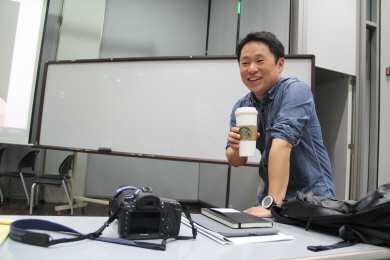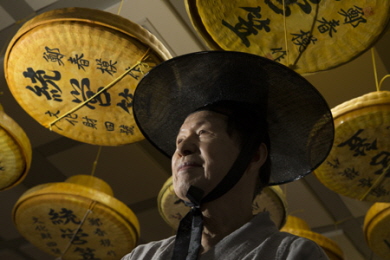

Photographer Choi Won-suk received a first prize from the Korea Press Photographers Association for his photo portraying a “gat (traditional Korean hat for men)” master, Chung Choon-mo. The 32-year-old photographer at Korea Times showed his earnestness to break the ice with the artisan in order to capture beautiful moments of the master’s life through the lens. Choi lied down on the floor and moved from corner to corner for a satisfying angle for a good shot.
The master, who never wears a gat he has made himself, put on the delicately threaded hat at Choi’s sincere request. As he tried his hand-made gat for the first time in his life, his face was lit up by a faint smile.
As can be seen from the case of the gat master, summarizing a person’s story into a photo is demanding for photo journalists.
“I encountered a man in his 50s who had been living with bipolar disorder since he was a teenager,” Choi recalled.
Spending eight hours every day for two months with the man, Choi created a photo essay of seven photos showing the man’s loneliness, unstable mind and weak personal relationships.
“Showing 200 photos of the reporting is not true journalism,” Choi remarked. “Journalism conveys the message or story of an event or person with concise editing.”
In this regard, Choi thinks photos and writings share similar traits. Once journalists record a moment they did not expect to get involved in, it is spot news for photojournalism and straight news for news writing. But when journalists investigate its issue and context, they get to build up a concrete piece of news.
A similarity is also found in another aspect: never overlooking your surroundings. Choi emphasizes the improtance of keen observation in daily life. Seven years ago, Namdaemun, the number one national treasure, was burnt down by an arsonist. Photos of Namdaemun he took routinely before the incident became an invaluable asset, because the original sophisticated beauty of the treasure can never be reflected through the lens no longer.
“I realized submitting assignments to the editor cannot be an utmost goal of a photographer. Collecting personal records of the society is equally or even more important.”
Believing that focusing on observation of our surroundings as a crucial habit a photojournalist should exercise, Choi finds division between fine-art photography and photojournalism unnecessary.
“The daily photos you upload on instagram could be selected by an editor at New York Times tomorrow morning,” Choi said. “Once your photos mark a page of a newspaper, then it becomes photojournalism.”
As a photographer, Choi emphasizes “one source, multiuse and multiplatform.” With the advance of media technology, photojournalism is facing a crisis as seen from the lay-off of Chicago Sun-Times’ photo staff, which even included a Pulitzer Prize winner. However, Choi believes in the potential of photojournalism with the “one source, multiuse” statement embedded in his mind. The internet has become a heaven for photojournalism as it allows countless combinations of layouts.
Furthermore, by adding direct sounds from the reporting site, silent and static images could now be in harmony with writings and sound effect, delivering more profound story or message.
As a photojournalist, Choi is constantly trying new techniques, perspectives, and angles. Choi thinks the role of a photographer is turning an ordinary scene of our lives into an extraordinary photo. That is why he emphasizes strict and tight preparation for every single photo shoot.
“Technical failure cannot be an excuse for a photojournalist. I think of various angles and lightings to reflect certain figure in the most dramatic and impressive way three or four days ahead of the interview.”
Lee Yoon-soo
yoonpamom@ewhain.net

